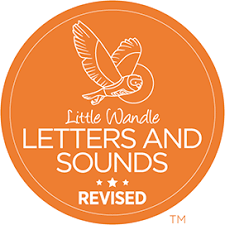Our Approach to Reading
Phonics Intent, Implementation and Impact
Phonics is an approach to teaching reading, and some aspects of writing, by developing learners’ phonemic awareness. This involves the skills of hearing, identifying and using phonemes or sounds patterns in English. The aim is to systematically teach learners the relation between these sounds and written spelling patterns, or graphemes, which represent them. Phonics emphasises the skills of decoding new words by sounding them out and combining or ‘blending’ the sound- spelling patterns.

At Roman Way, we teach phonics using Little Wandle Letters and Sounds Revised which is a systematic and synthetic phonics programme to support early reading. Because we believe teaching every child to read is so important, we have a Reading Leader who drives the early reading programme in our school. This person is highly skilled at teaching phonics and reading, and monitors and supports our reading team, so everyone teaches with fidelity to the Little Wandle Letters and Sounds Revised programme. All the staff are trained in teaching this new scheme, ensuring the consistency is established from Reception to KS2. Weekly phonics CPD is delivered to all the staff by the Reading leader to coach and build the team. Phonics workshops are held for EYFS and KS1 parents in the Autumn term.
How is Phonics taught at RWA
We start teaching phonics in Nursery/Reception and follow the Little Wandle Letters and Sounds Revised progression, which ensures children build on their growing knowledge of the alphabetic code, mastering phonics to read and spell as they move through school. We want all our children are able to tackle any unfamiliar words as they read. We also model the application of the alphabetic code through phonics in shared reading and writing, both inside and outside of the phonics lesson and across the curriculum.
In Reception and KS1, pupils have phonics lesson at least once daily. From Year 2 onwards, teachers use the No Nonsense Spelling (NNS) scheme and Grammarsaurus (GRS) to support the teaching and learning of spellings to most of the pupils. SPAG lessons take place daily in Year 2 and at least 5 times over 2 weeks in KS2.
Summative assessment for Reception and Year 1 is used every six weeks to assess progress, to identify gaps in learning that need to be addressed, to identify any children needing additional support and to plan the Keep-up support that they need. The data is scrutinised through the Little Wandle Letters and Sounds Revised assessment tracker, to narrow attainment gaps between different groups of children and so that any additional support for teachers can be put into place and this is monitored by the Reading leader and the SLT.
Any child who needs additional practice in Reception and in KS1 has daily Keep-up support taught by a fully trained adult. We timetable daily phonics lessons for any child in Year 2 and above who is not fully fluent at reading or has not passed the Phonics Screening Check. These children urgently need to catch up, so the gap
between themselves and their peers does not widen. We use the Rapid Catch-up assessments in KS2 to identify the gaps in their phonic knowledge and teach to these using the Rapid Catch-up resources – at pace. These short, sharp lessons last 15-20 minutes daily and have been designed to ensure children quickly catch up to age-related expectations in reading.
Pupils in Year 1 also do the Phonics Screening Check (PSC) in June and the pupils in Year 2 who didn’t meet the expected score marks. This is a statutory test, set by the government, to assess children’s ability to decode words using phonics. To help the pupils achieve this, the pupils in Year 1 and in Year 2 do a mock PSC every term during assessment week so that their progress is measured and interventions can be put in place where needed.
For more information about this, please click on the link below:
Learning to read through phonics
Parent Guide: What is the Phonics Screening Check?
Reading Intent, Implementation and Impact
At Roman Way Academy, we value reading as a crucial life skill. We believe that all our children can become enthusiastic, fluent readers and writers. Our readers are equipped with the tools to tackle unfamiliar vocabulary. We encourage our children to see themselves as readers for both pleasure and purpose. By the time children leave us, they read confidently for meaning and regularly enjoy reading for pleasure. The children are introduced to enriched, high quality books, from a variety of cultures and in a range of different styles and formats including non-fiction, fiction, poetry and drama.
How we teach reading at RWA
All Reception and KS1 pupils engage in reading practice. Through shared and reading practice sessions, children experience good models of reading and reading discussion, using a variety of quality texts written for a range of purposes.
- In Reception and KS1, each child has ‘reading practice sessions’ three times a week.
- In Key Stage 2, pupils participate in whole class guided reading sessions and this happens 3 times a week as well.
- Quality texts are also chosen to share during daily reading for pleasure time.
- Younger children, children who do not get much support at home and those falling behind in their reading will have more frequent opportunities to read independently with an adult.
Resources for home reading
Foundation and Key Stage 1
Once a week, children take home a book that matches their current phonics phase. This is to be read with their parent/carer at home and should be read independently by the child. Children also take a library ‘reading for pleasure’ book to share with their adult at home. We use the Big Cat Little Wandle phonics books.
Children who are in Year 2, who are secure with phase 5 phonics, take home a colour banded book.
Key Stage 2
Children continue to use the colour banded book schemes as necessary and then move onto a range of free reading books.
Assessment
Reading assessment is recorded termly on Insight. Children are given immediate feedback when listened to during reading practice sessions and when reading 1:1.
Fluency assessments measure children’s accuracy and reading speed in short one- minute assessments which are used in Year 1, when children are reading the Phase 5 set 3, 4 and 5 books, with children following the Rapid Catch-up programme in Years 2 to 4, when they are reading the Phase 5 set 3, 4 and 5 books and to assess when children are ready to exit their programme. For Year 1 children, this is when they read the final fluency assessment at 60–70+ words per minute. Older children can exit the Rapid Catch-up programme when they read the final fluency assessment at 90+ words per minute. At these levels, children should have sufficient fluency to tackle any book at age-related expectations. After exiting their programme, children do not need to read any more fully decodable books.
